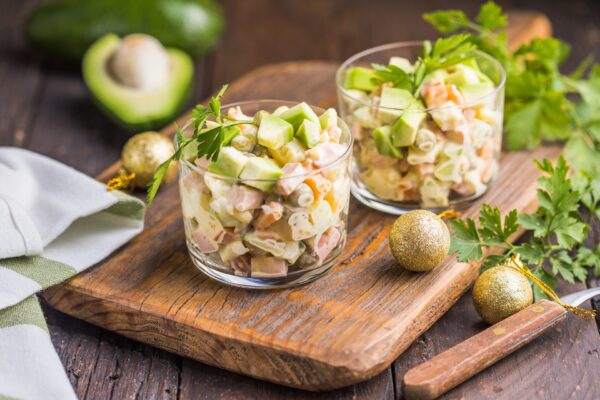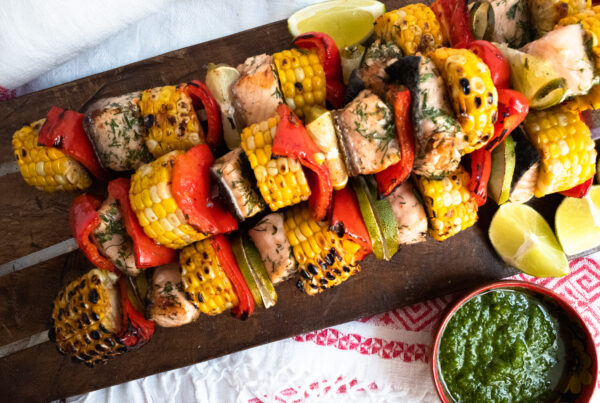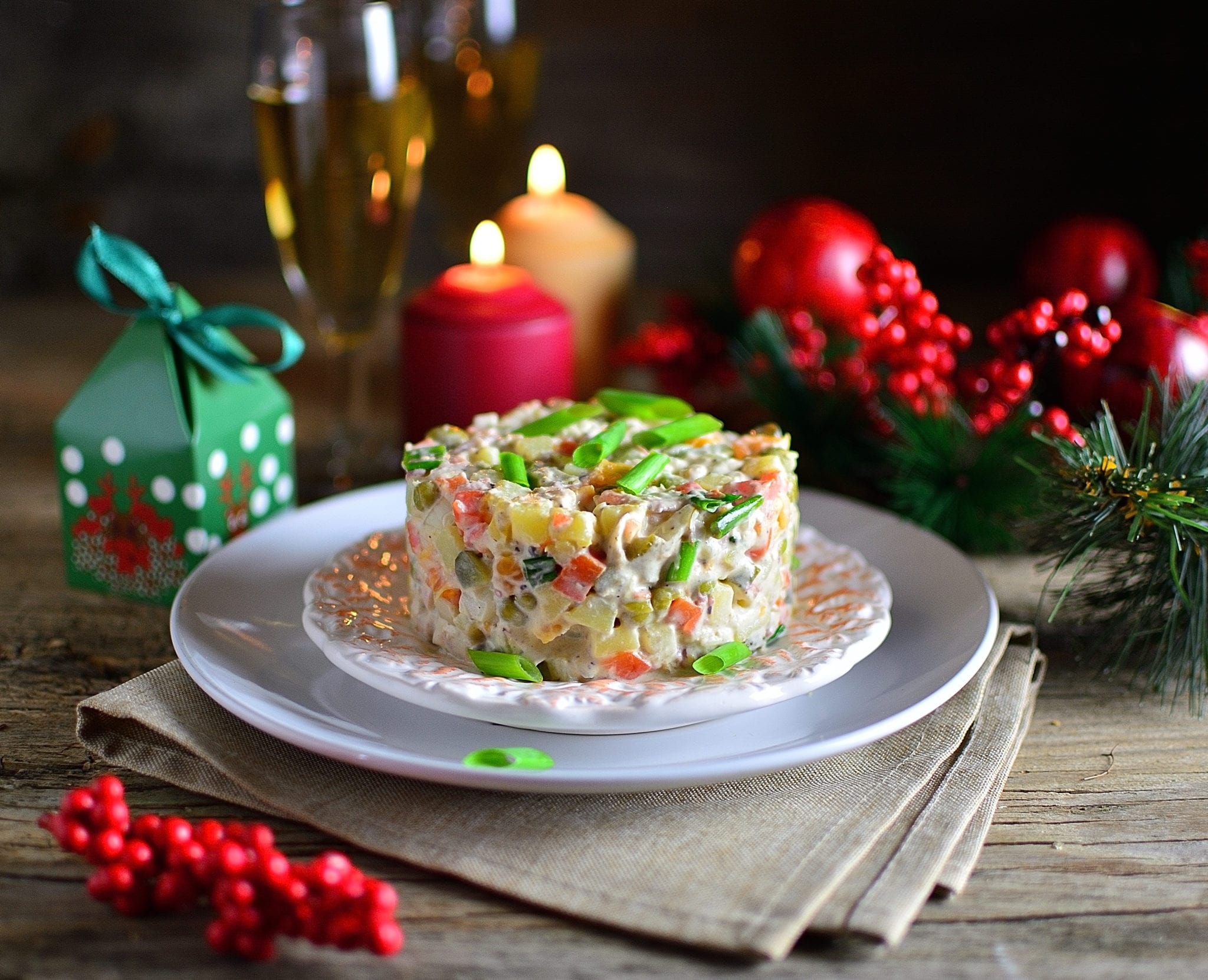
Salat Olivier takes center stage in the Eastern European holiday line up. This beloved mayonnaise-based potato salad has had a long and storied history invented during the heyday of Imperial Russia by a brilliant foreign chef. It featured exotic ingredients and was a crowd pleaser. After a decline in quality during the Soviet era, Salat Olivier is still an all-important holiday dish.
This post contains affiliate links, including links from the Amazon Associates programs. These links will direct you to products I recommend for further exploration and enjoyment of the topics I cover on my website and in my lectures. See more in the Privacy Policy below.
Olivier Potato Salad The Centerpiece of the Easter European New Year
I don’t know what you’ll be doing on New Year’s Eve: probably getting your nails done and your hair blown out to prepare for a glitzy evening. Me? I’ll be up to my elbows in mayonnaise.
The classic Soviet era New Year’s menu is as resistant to change as the current regime. It all hinges on two mandatory, incredibly labor-intensive, mayonnaise-based cold salads: Salad Olivier, the traditional Russian potato salad (also known as salat olivye, olivye salad, salat olivier, ensaladilla rusa, ensalada rusa, salada russa, olivieh salad, and rus salatası), and Herring Under Fur Coat. While baffling in their appeal to any but the Russian palate, these nevertheless take pride of place on the festive board, alongside other zakuska: smoked meats, salted and smoked fish, caviar, and marinated and pickled vegetables.
Everyone thinks theirs is the best Salat Olivier salad recipe. In one of the opening scenes of the iconic Russian holiday film “The Irony of Fate,” the hero Zhenya’s mother resignedly dices potatoes, carrots, dill pickles, and Russian bologna for Russian Olivier salad to prepare for the upcoming new year’s celebration. She comments, in that long-suffering Orthodox Christian martyr manner Russian mothers-in-law have perfected down the ages, that Zhenya’s girlfriend, Galya, appears to be too busy to make the traditional New Year’s Menu for him, telling us all we need to know about Galya.
When a series of comical events forces Zhenya to spend New Year’s Eve with a different woman, Nadya, he drunkenly offers a very disparaging critique of her salads. From this, we understand that Zhenya and Nadya’s long (like really, really long) process of falling in love has hit (yet another) speed bump in their (really, really, really long) journey to Happily Ever After.
The message of “Irony of Fate” is abundantly clear: if you want to get to Happily Ever After with your own romantic hero, then you too must master the art of the Russian New Year’s salad. And I’ve spent about two decades doing just that, which is why I now feel entitled to exercise a teeny bit of poetic license.
Learn more about great Russian Films with Jennifer’s Top Ten!
Looking for a great listen as you cook? Check out my podcast review
My Own Spin on Salat Olivier: Returning the Recipe to The Original Ingredients
Salat Olivier is the sine qua non of the New Year’s Eve menu. Everyone knows that. As much as I would love to divide the ingredients into separate and far more appetizing, like minted peas and roasted carrots alongside a creamy Dauphinoise potato, that will not fly. Everything gets dumped into a large bowl and mixed up with copious amounts of mayonnaise and sour cream.
But there is nothing in the unwritten playbook which prevents me from reverting to the original salad, pre-revolutionary recipe of Salat Olivier, which resembles the Soviet version as the Orient Express is to Metro North.
The Belgian Origins of Russia’s Most Iconic Holiday Dish
The creator of the original Russian salad recipe was not Russian at all, but renowned Belgian Chef Lucien Olivier. He invented this superstar of potato salad recipes — the salad that bears a version of his name — the late 19th century for an upscale Moscow restaurant. When the original recipe debuted, it was an instant hit with the restaurant’s tony patrons, largely thanks to the secret sauce, which Olivier kept a closely guarded secret throughout his life and ultimately took to his grave. We know, however, from enthusiastic contemporary accounts that it was subtly tart, velvety smooth, and slightly spicy.
Several nineteenth-century cookbook writers attempted to recreate the recipe, creating their own versions of Olivier salad, listing many fancy ingredients such as grouse and crayfish tails, which, let’s agree, are far more intriguing than bland, tinned ham.
It was the word “aspic,” in a recipe by P.P. Alexandrova-Ignatieva, in her 1909 cookbook The Practical Basics of the Culinary Arts that got me excited. Both mayonnaise and aspic arrived in Russia with the European chefs, who made elaborate decorative dishes of game and fish molded into their original shapes, coated with aspic. These dishes served in the smart salons and banqueting halls of the Russian nobility were usually served decorated with Sauce Provençal or mayonnaise. Mayonnaise and aspic marched through late Imperial Russian cuisine like twin warriors.
My version of Salad Olivier is no less time consuming than the Soviet version — it will take you a couple of hours to prep the vegetables, cutting them into a half inch dice (though a good mandoline can save lots of time and energy) and make the aspic. Some readers have raised their eyebrows at the seemingly unnecessary step of adding gelatin cubes, but trust me, it really elevates this unique potato salad into something very special: even HRH admits he prefers this version to any other, and always requests it on any special occasion.
Russian Potato Salad: Salat Olivier
Ingredients
- The Salad
- 3 medium-sized red potatoes
- 3 fresh carrots
- 1 tsp of olive oil
- 1 cup of cubed lardons of pancetta cut into cubes
- 3 cups of seared duck breast or smoked turkey
- 1 cup of French cornichons cut into cubes the same size as the carrots
- 1 cup of frozen or canned peas
- The Aspic:
- 2 envelopes of gelatin
- 1.5 quarts of clarified chicken stock
- 1 cup of Madeira or dry white wine
- The Sauce:
- The juice of 2 lemons divided into two batches
- Tabasco to taste
- 2 egg yolks
- 2 tsps. of fresh lemon zest
- 2 anchovy fillets mashed
- 1 shallot finely minced
- 3 Tbls of capers
- 2 Tbls Dijon mustard
- 1-1/2 cups of best quality olive oil
- 3 cloves of garlic
- 4 green onions for garnish
- Salt and pepper to taste
- The Garnish:
- Minced chives fresh dill, green onion, and finely chopped Italian parsley
Instructions
- Prepare the gelatin the day before:
- Line a rimmed baking sheet with parchment paper.
- Proof the gelatin with 1 cup of cold chicken stock. Bring the remaining chicken stock, Madeira, and Tabasco to a simmer. Add the mixture to the proofed gelatin and cool to room temperature, stirring frequently.
- Pour the cooled gelatin into the rimmed baking sheet and chill overnight.
- Prepare the Remaining Salad Ingredients
- Boil the unpeeled potatoes in a separate pot until the point of a knife slides in with ease. Do not overcook them — you want them to keep their shape. Chill them for at least 2 hours, then peel and cut them into a fine dice.
- Dice the carrots, then toss them with olive oil and sprinkle them with salt. Roast them for 15 minutes in a 450ºF/220ºC oven. Let cool completely.
- Plunge the frozen peas into a small saucepan of rapidly boiling, salted water. Let simmer for 1-2 minutes. Drain, then immerse in a small bowl with cold water. This will help them keep their bright color. If you are using tinned peas, drain them and rinse them thoroughly.
- Fry the bacon lardons/pancetta until the fat is rendered. Remove to a plate covered with a paper towel to drain.
- You can prepare these ingredients 1-2 days before, keeping them in the refrigerator in a non-reactive bowl covered with plastic wrap.
- Make the Sauce several hours before serving
- Combine the garlic cloves, anchovy fillet, mustard, lemon zest, capers, and shallot with one tsp. of salt and several grinds of fresh black pepper in a food processor fitted with a steel blade. Pulse to combine into a rough paste.
- Add the egg yolks, then slowly add the olive oil in a fine drizzle until the mixture thickens.
- Taste and adjust seasoning with Tabasco, salt and pepper.
- Chill for at least 3 hours to allow the flavors to combine and bloom and the texture to thicken.
- Assemble the Salad:
- Decant the cornichons from their jar, drain well and cut into cubes.
- Toss the salad ingredients lightly in a big bowl with approximately three-quarters of the sauce.
- Taste to adjust seasoning with salt and pepper and perhaps a bit more sauce. The sauce should lightly coat the ingredients, not drown them.
- Remove the aspic from the refrigerator and gently slice into small cubes. Don’t worry if these don’t hold their shape — the taste is the main thing. Return to the refrigerator until you are ready to serve.
- As gently as you can, fold the gelatin cubes into the salad.
- Garnish with Parsley and Chives
Notes
How to Serve Salat Olivier
My preferred method for serving Salad Olivier is to scoop small amounts into pastry tart shells, individual china ramekins, small ceramic serving spoons, or in small shot glasses. The presentation looks better than a massive mound of potato salad, and single servings won’t slip and slide as much as the evening progresses. Of course, when the evening is over, all bets are off, and the dish reverts to the comfort food/hangover blotting paper it is!
Frequently Asked Questions about Salad Olivier
Is Salat Olivye a French Salad or from Russian or Ukrainian cuisine?
Salat Olivye was created by Belgian chef Lucien Olivier in Imperial Russia in the 1860s. During this period Ukraine was part of the Russian Empire, which makes the salad both Russian and Ukrainian, and Belgian, but not French.
What do they call Russian Salad in Russia?
Salat Olivye, Olivye salad, Salat Olivier,
What is a Russian potato salad made of?
When do Russians consume Salat Olivye?
Salat Olivye is consumed on special occasions, most noticeably on Newew Year’s Eve along with other mayonnaise-based salads.
How long can Salat Olivier last in the refrigerator?
Keep any leftover Salat Olivier in an airtight container for 3-4 days after you’ve made it.
What is Ensalada Rusa?
Ensalada Rusa or Russian Salad was brought from Imperial Russia to Europe, from which it moved to South America with Russian emigres, where it is a popular side dish.
Thank you for stopping by!
Thank you for stopping by and I hope you’ve enjoyed pursuing this article! There are plenty more to enjoy — check out the list below!
I am a food and travel writer as well as a cruise ship lecturer: my passion is exploring the cuisine, history, and culture of new places and writing about them here.
I hope you’ll consider staying connected with me by subscribing to my newsletter, Destination Curation, where I look at the intersection of history, culture, and cuisine in major destinations. You can also join the conversation on Facebook, Twitter, Instagram, and Pinterest!
Enjoy More Posts Like This One
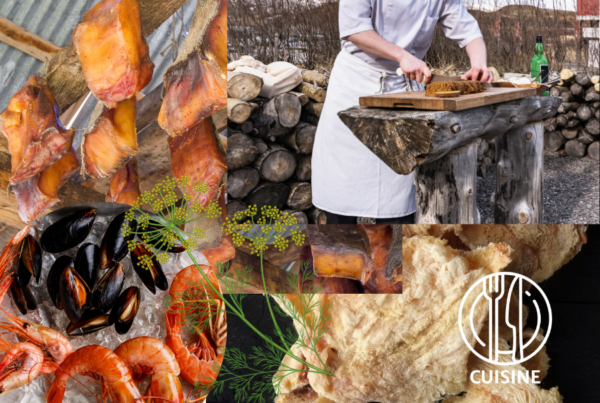 The Must-Try Things to Eat and Drink in Iceland
The Must-Try Things to Eat and Drink in Iceland
The Must-Try Things to Eat and Drink in Iceland
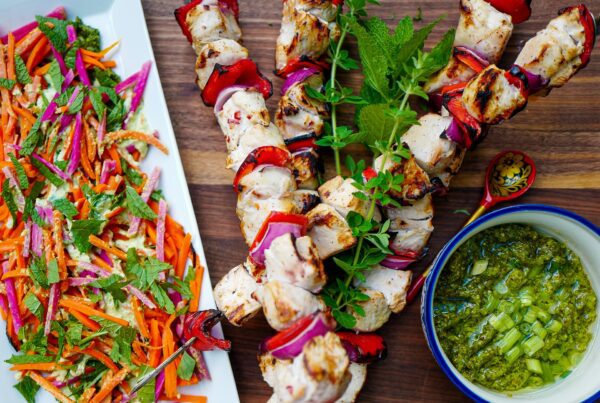 Tangy Kefir Brined Chicken Shashlik
Tangy Kefir Brined Chicken Shashlik
Tangy Kefir Brined Chicken Shashlik
 How to Make Shashlik: Recipes for Juicy Meat Skewers
How to Make Shashlik: Recipes for Juicy Meat Skewers
How to Make Shashlik: Recipes for Juicy Meat Skewers
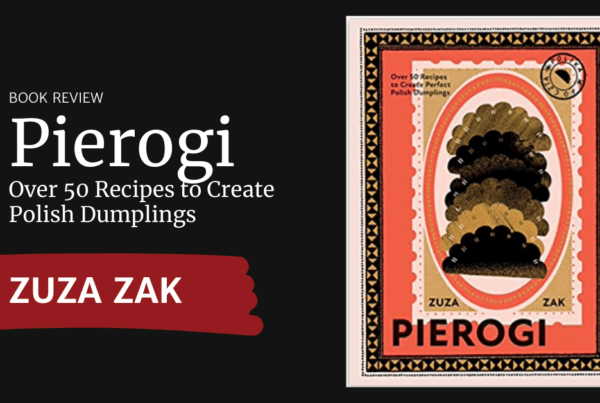 Pierogi: Over 50 Recipes to Create Perfect Polish Dumplings
Pierogi: Over 50 Recipes to Create Perfect Polish Dumplings
Pierogi: Over 50 Recipes to Create Perfect Polish Dumplings
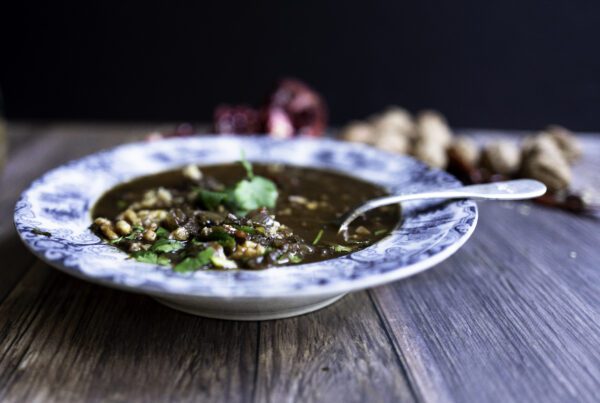 Kharcho: A Welcome Guest From the Near Abroad
Kharcho: A Welcome Guest From the Near Abroad
Kharcho: A Welcome Guest From the Near Abroad
 Amber & Rye: A Baltic Food Journey
Amber & Rye: A Baltic Food Journey
Amber & Rye: A Baltic Food Journey
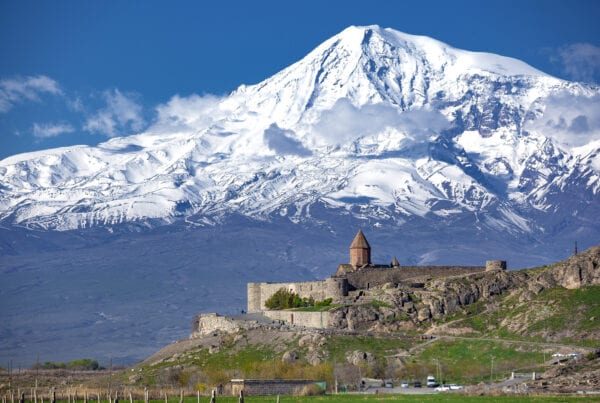 The Mysteries of Mount Ararat
The Mysteries of Mount Ararat
The Mysteries of Mount Ararat
 Podcast: Carpathia: Food from the Heart of Romania
Podcast: Carpathia: Food from the Heart of Romania
Podcast: Carpathia: Food from the Heart of Romania
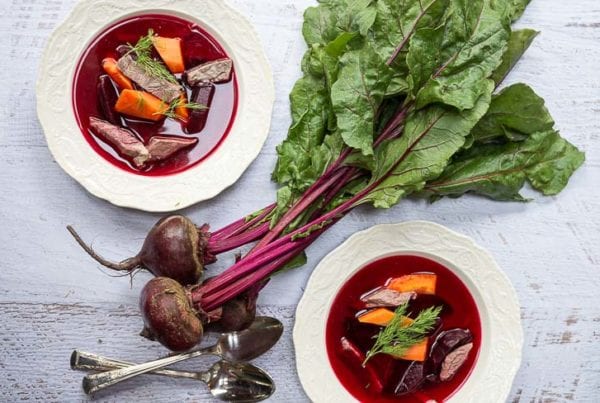 New England Borsch? Really?
New England Borsch? Really?
New England Borsch? Really?
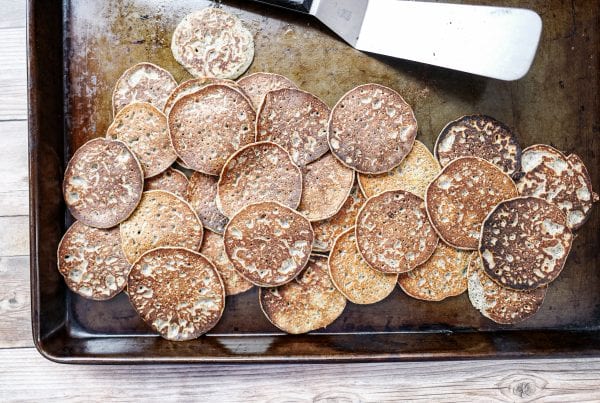 Buttery Blini for Russian Maslenitsa
Buttery Blini for Russian Maslenitsa


